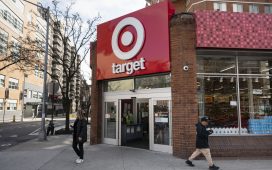Unlock the Editor’s Digest for free
Roula Khalaf, Editor of the FT, selects her favourite stories in this weekly newsletter.
After searching for trainers at the JD Sports store on London’s Oxford Street, Maisy Martin-Hill left empty-handed.
“I spend way less than I would usually spend in a place like this because I need other things,” she said on Thursday.
The 18-year-old student is not alone in her reluctance to splash out on trainers. Hours earlier, JD Sports alarmed investors by warning annual profits would fall short of expectations as consumers retrenched, sending its shares down 16 per cent.
It was a rare mis-step for a company whose success over the past decade has transformed it into one of the UK’s biggest retailers. Aggressive acquisitions pushed it into more than 30 countries, including the US, where it now generates 30 per cent of its revenue.
While the severe reaction from shareholders was partly down to the retailer’s previously strong record, analysts said that it will put chief executive Régis Schultz’s ambitions to sustain the group’s global expansion plans under more scrutiny.
The “execution risk was probably higher than average given the company’s pace of expansion”, noted analysts at RBC Capital Markets.
Schultz, a French executive who succeeded JD Sports’ longstanding boss Peter Cowgill in 2022, told investors last year he intended to turn the chain into a “global sports-fashion powerhouse” and invest up to £3bn to open as many as 1,750 stores worldwide. It currently has 3,400 stores.
Cowgill had targeted the US, a prized market but one that has historically tripped up UK retailers, through two major acquisitions, Finish Line in Indiana and DTLR in Baltimore. Since taking over, Schultz has boosted expansion by orchestrating several deals in Europe.
JD Sports pinned some of the blame for its weaker performance on a heavy discounting in a highly competitive market, pointing to “elevated levels” of promotional activity. The retailer did not break down the performance by region, but analysts at Investec believe the biggest squeeze on profits will have come from the UK and the US.
Last month, Nike, a key supplier to JD Sports, said it would be cutting $2bn in costs over the next three years as sales fell in the US and Europe. Adidas also reported falling sales in November partly because of sluggish performance in North America.
“The promotional nature of the US market has been unhelpful,” said Jonathan Pritchard, an analyst at Peel Hunt. “This time last year there were a lot of promotions on old stock, this year there are promotions on everything. You can’t really not participate in those circumstances.”
Signs of strain in the wider market for sportswear comes despite growing expectations that interest rates in the US and the UK have peaked, providing some relief to consumers.
UK fashion retailer Next on Thursday lifted its profit forecasts, pointing to the more benign backdrop for consumers as energy and food inflation eases.
Russ Mould at AJ Bell said JD Sports would likely benefit from any interest rate cuts from the Bank of England but would also have to find innovative ways to shift more stock without sacrificing too much profit margin.
The company said it was comfortable with its inventory position as the end of its financial year on February 3 approaches. Even as the broader backdrop deteriorates, JD Sports continues to have a strong balance sheet and Schultz said the company was “confident in our strategy”.
For the full year, JD Sports, which also owns Go Outdoors brand, said it now expected pre-tax adjusted profits of between £915mn to £935mn, down from a previous forecast of £1.04bn.
Given the challenges now facing JD Sports, analysts said rivals will come under pressure to sharpen their game to compete in a more difficult market while Pritchard at Peel Hunt noted the retailer is still winning market share.
JD Sports should also continue to be a preferred seller for the likes of Nike and Adidas, said RBC Capital Markets — a competitive edge when new shoe models are released.
Pritchard added that “the new launches have not necessarily captured the imagination at a time when the consumer is fairly cautious anyway”, which has contributed to its recent struggles.
A bright spot in the UK, which is only narrowly ahead of the US as the retailer’s largest market, could be the Uefa Euro football tournament this summer if England’s team performs well.
But, for now at least, the retailer is navigating a market far tougher than it was accustomed to during its decade of buccaneering expansion.
As he left the group’s flagship store on Oxford Street on Thursday, Stephen Leather, a thriller writer, said he was far more price conscious than he had been. “It’s just being a bit more careful with discretionary spending.”









